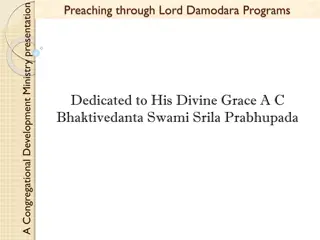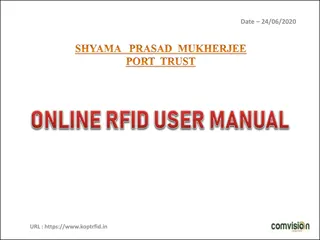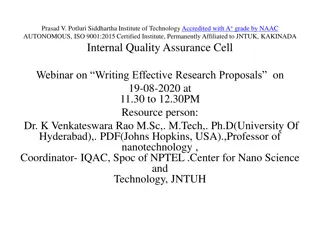
Understanding Dating Techniques in Evolutionary Investigations
Explore the significance of dating techniques in evolutionary studies, including absolute and relative dating methods, with a focus on how researchers determine the age of objects using various approaches such as C14 and K-Ar dating. Learn about the principles of stratigraphic dating and its importance in understanding the history of stratified rocks.
Download Presentation

Please find below an Image/Link to download the presentation.
The content on the website is provided AS IS for your information and personal use only. It may not be sold, licensed, or shared on other websites without obtaining consent from the author. If you encounter any issues during the download, it is possible that the publisher has removed the file from their server.
You are allowed to download the files provided on this website for personal or commercial use, subject to the condition that they are used lawfully. All files are the property of their respective owners.
The content on the website is provided AS IS for your information and personal use only. It may not be sold, licensed, or shared on other websites without obtaining consent from the author.
E N D
Presentation Transcript
Dating Techniques Dr. D.V. Prasad Department of Sociology & Social Anthropology Indira Gandhi National Tribal University, Amarkantak, MP. dvprasada@gmail.com, Mob:9479790983
Introduction Dating is an indispensable tool in the field of evolutionary investigations. It helps researchers to make a better assessment of time of any relict objects like Fossils, Artefacts and also Geological deposits. There are two different approaches to dating, namely- I. Absolute or Chronometric Dating and II. Relative Dating
Absolute dating Absolute dating determines the age of an object in calendrical years. There are many such dating methods such as C14 or Carbon 14 method of dating, U238 method of dating, K-Ar or Potassium-Argon method of dating etc. Any of these methods is not applicable for all archaeological findings. Because the age range of each method is applicable for a particular time span and any archaeological object is not applicable for all methods of dating. Thus each method has its own time limit and object or material specialty e.g. C14 method is applicable only on organic materials, while K-Ar method is applicable on volcanic deposits.
Relative Dating gives information about the age of an object in relation to other objects. In another way, it can be said that this dating method can determine whether any object is older or younger than other objects. With the help of this method of dating archaeologists can group or rank various archaeological materials like artifacts, fossils etc. according to their relative age. Thus, the relative method of dating produces only comparisons of age or date, not actual or calendrical date of an object. Stratigraphic analysis is an essential component of this method of dating. Besides Fluorine test method help to determine the relative age of different objects belonging to the same stratum. In possible cases, the technique of Palynology and Pedology is also applied to achieve a more or less correct date for an object.
Stratigraphic Dating Method Stratigraphic Dating Method Stratigraphy is a sub-discipline of Geology. It is the study of the origin, physical characteristics and spatial relationships of stratified rocks, primarily to understand the history of events documented in the strata (Delson et al, 2004). Usually sedimentary rocks are studied in stratigraphy, however layered igneous rocks and even layered metamorphosed rocks can also be studied using principles of stratigraphy. The science of stratigraphy is mainly governed by three basic principles or laws; Principle of Superposition, Principle of original Horizontality and Principle of Lateral Continuity.
The principle of superposition says that if one series of rock lies above another then the upper series was formed after the lower series (Walker, 2005). The principle of original horizontality says that strata are horizontal or nearly so when they are deposited; principle of lateral continuity said that all parts of a stratum, disrupted by lateral activity, were once joined in a single connected layer. Stratigraphy is used to date rocks and fossils of an area on the basis of the principle of superposition. This principle helps geologists and archaeologists to put various historical events in order. Succession of events in one area can be correlated with other on the basis of original horizontality and principle of lateral continuity. Sometimes it can be done by comparing fossils of two areas or by the use of the knowledge of biostratigraphy.
In Stratigraphy rock strata are classified according to their nature and age of origin, lithological components and biological components. On the basis of the said features, three different branches of stratigraphy- lithostratigraphy, biostratigraphy and chronostratigraphy have been developed. Lithostratigraphic studies are based only on the nature of rocks and minerals of stratigraphic units alone. Various lithostratigraphic units can be classified as laminae, bed, formation, groups etc. on the basis of their lateral extent and relative thickness in a particular area. Biostratigraphy classifies various Stratigraphic units on the basis of the fossils found in each of them.
Biostratigrapher tries to correlate various Stratigraphic units on the basis of evolutionary relationship or absolute age of the fossil remains found in various strata. Chronostratigraphy tries to correlate various Stratigraphic units on the basis of their relative age. The major objective of chronostratigraphy is to gather all strata of the same age into the same chronostratigraphic unit
Fluorine Dating Analysis Fluorine analysis is one of the most widely used relative dating methods. This method of dating is used to compare age of fossilized bones buried underground for a long time. Like other relative dating methods discussed previously this dating method cannot determine the actual age of any bone but it can compare the age of the fossilized bone buried under the soil for a longer time. Studies have shown that fluorine is widely distributed in the form of soluble fluorides which occur in trace quantities in ground water. When fluorine ions come into contact with buried bones and teeth, they are absorbed and become locked in it by replacing hydroxyl ions of the bone in the ultramicroscopic crystals of hydroxyapatite
and as a result of this, those hydroxyapatite ions changes into fluorapatite ions. When fluorine atoms have once been fixed in bone, they are not readily dissolved out. In course of time buried bones and teeth deposit fluorine progressively. The rate at which fluorine deposits occur in bone varies from one region to the other; however bones that are deposited in soil in a same period of time will have approximately same amount of fluorine content within them. As the fluorine content in a fossilized bone is fixed in amount, a fossilized bone which has been washed out of a much older deposit and re-deposited in a younger one will have higher fluorine content than fossil bones of younger deposit.
Fluorine to phosphate ratio in a fossilized bone is established by X-Ray diffraction technique. This method is particularly useful when bones have accumulated in sand and gravel deposits, but difficulties have been found in lime stone deposits where it has been observed that the accumulation of fluorine ions on the bone is inhibited whereas the decay of organic matters in bone proceeds at normal rates (Lowe and Walker, 1984:272-273). Fluorine dating was used to uncover the Piltdown hoax, in which a skull was fabricated from bones of different species and age and allegedly represented a human ancestor (Truncer, 2008, cited in Pearsal, 2008:108
Pollen Analysis This method of dating is sometimes known as Palynology. It is the microscopic identification of the pollen grains of particular species of plants in soil samples recovered from a particular site. By identifying the plants growing in a locality at some time in the past, and by counting the relative number of pollen grains from different plants in a Stratigraphic sequence, it becomes possible to develop pollen diagram which summarizes the shifting of vegetation pattern over time. Work on pollen began in Scandinevia in the 1920s and it confirmed the general pattern of climatic change that had been proposed from visible plant remains. In this way Palynologists became able to develop a model, reflecting changes in past climatic condition.
The value of this technique for archaeology lay in the fact that climatic phases were likely to have been fairly uniform for a particular region. Thus, plant species found in a sample of pollen from an archaeological site could be fitted into the climatic sequence. Correlations could be established between sites belonging to similar climatic phases in different countries. With the help of this technique even individual artefacts could be dated if they were found in peatbogs, or if they had sufficient soil attached to them for the identification of pollen. For example, a Mesolithic bone harpoon dredged from the bottom of the North Sea was placed into the period when pine was declining in favour of trees that preferred warmer conditions around 7000 BC
Obsidian Hydration Method of Dating Obsidian Hydration Method of Dating Obsidian hydration method of dating is based on the fact that a freshly broken surface of Obsidian, a variety of naturally volcanic glass, will absorb from its surroundings to form a measurable hydration layer, known as Perlite (Friedman and Long, 1976, cited in Lowe and Walker, 1984:273). This layer is not visible to the naked eye and should not be confused with the Patina , which develops on many materials as a result of alteration or chemical weathering. The hydration begins at the moment the surface is exposed by chipping or flaking and the penetration of water into the artifact continues at a known rate until the present time. Thus, when ancient man chipped or flaked a piece of Obsidian, he exposed a fresh surface on which hydration started. Measurement of the depth of penetration of hydration on the artifact depicts a measure of time that elapsed since the manufacture of the artifact
Calculating the hydration rate can be difficult, however, since the rate is dependent on composition, moisture, temperature, and pressure. Even so, obtaining sufficient estimates for these attributes is far from impossible, and many successful applications of obsidian hydration have been made. In a relative- dating role, obsidian hydration offers the possibility of identifying and ordering assemblages of mixed age. In addition, because the chemical composition of obsidian differs significantly from outcrop to outcrop, provenance studies have been very successful in accurately characterizing different sources and allocating artifacts to them. Such provenance information, when combined with the chronological information of obsidian hydration, provides a powerful set of tools to document change in the archaeological record



















